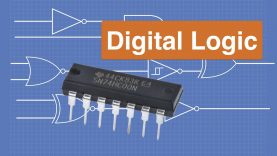Using Basic Logic Gates – With & Without Arduino
Learn how to use basic logic gates, both with and without an Arduino. We’ll work with some basic gates and we’ll add one to an Arduino to build a simple intruder alarm.
Article with code: https://dbot.ws/baslog
More articles and tutorials: https://dronebotworkshop.com
Join the conversation on the forum: https://forum.dronebotworkshop.com
Subscribe to the newsletter and stay in touch: https://dbot.ws/dbnews
This video is an hour long! You can use the clickable Table of Contents below to skip to the part that interests you most.
……………………………………………………………………………………
Finally, back in the workshop, this time working with chips that have been around for over half a century, but which still have a place in modern designs.
Basic logic gates are the backbone of all electronic devices. And while most of our focus these days is upon microcontrollers and microcomputers we can still find a use for these elementary electronic components. They are cheap, readily available, and they don’t require any programming.
We’ll start off by going through the seven types of elementary gates. We’ll then look at the different logic “families’ that have evolved since these devices were first introduced in the 1960s.
After working with some elementary gates on a breadboard we’ll bring an Arduino into the picture for a couple of experiments.
First, we’ll see how to emulate all of the basic gates in code by building an Arduino logic emulator. This is actually a practical teaching device for this learning digital electronics, and it also will familiarize you with using Boolean algebra in your Arduino sketches.
Then we will combine a logic chip and an Arduino to make a simple but functional intruder alarm with both Open-Loop and Closed-Loop sensor inputs. It’s a simple circuit that you can expand upon to create a practical device, and it serves to illustrate how combining logic chips with modern microcontrollers can be a powerful design technique.
It’s a long video so you might want to jump to the section that interests you most.
Here is the Table of Contents for today’s video:
00:00 – Introduction
04:08 – Basic Logic Gates
10:03 – Online Logic Gate Simulator
14:10 – Buffers & Schmitt Triggers
19:37 – Logic Gate Families
28:14 – Logic Gate Test Demo
34:46 – 3-State Logic Demo
38:57 – Arduino Logic Gate Emulator
47:17 – Intruder Alarm
After watching this I hope you’ll see that these chips are still very useful, despite their age.
Hope you enjoy the video, and I promise that I won’t make you wait as long for the next one!
Bill
source











